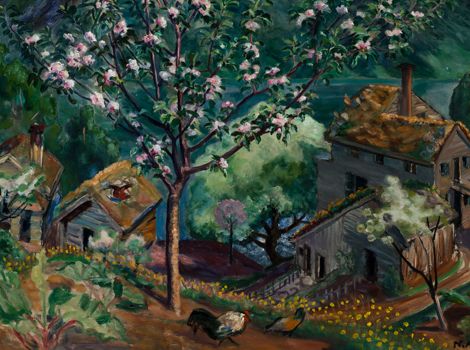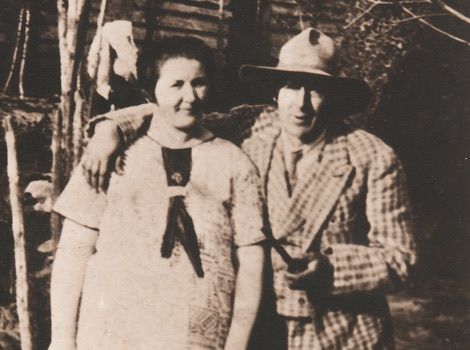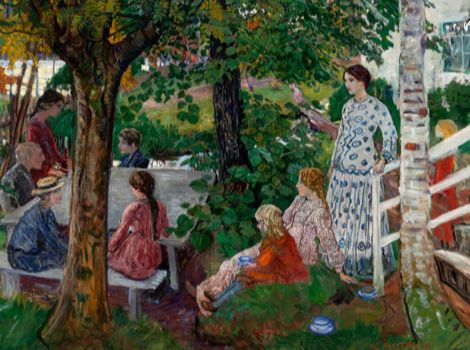Contents and Navigation
THE ARCHIVE
The digital archive contains letters and manuscripts written by or to Nikolai Astrup. The letter category includes complete letters, letter drafts, letter fragments, postcards and envelopes. These are essentially letters written by Astrup, but the archive also contains letters to the artist, or correspondence between other persons, that have content relevant to Astrup and his art. The manuscripts are written by Astrup and include complete manuscripts, manuscripts with drawings, manuscript fragments and notebooks.
The material has been collected, transcribed and translated in connection with the creation of a catalogue raisonné of Astrup’s works. The archive contains material from various private and public collections. The English edition is a collaboration between translator Francesca M. Nichols and members of the Astrup Research Centre.
The digital archive was published in the autumn of 2021 and is updated continuously, as new material comes to light.
ADVANCED SEARCH
A search in the archive can be carried out by using any words in the search window. The search can be limited by dates or by choosing the following types of documents: Postcard; Letter; Letter draft; Letter fragment; Envelope; Manuscript; Manuscript with drawings; Manuscript fragment; Notebook.
The results are listed on the right and can be sorted alphabetically (A to Å, or Å to A), or chronologically, with the oldest or the most recent documents first (arrows).
VIEW DISPLAY
The view displays contain a reference to the original document, credit for transcription and translation, and pagination. In addition, it is possible to switch between the transcription and the English translation, where these are available. A facsimile of the document is shown on the right.
Reference
For the letters, the view display contains complete references, including the author and recipient, the date, archive number and owner of the document.
For manuscripts, the view display contains complete references, including author, title, date, archive number and the owner of the document. If the title is unknown or unresolved, the document’s first five words serve as the title.
The owners include the National Library of Norway, the University of Bergen Library, the Public Library in Sunnfjord, Astruptunet, Kode and private collections. The identities of the private owners remain anonymous. When underlined, it means that the original document has been digitalised and made available by the owner institution (and is thus an active link that allows direct access to the original location in their digital archive).
Transcription
The transcriptions seek to reflect the original texts to the greatest extent possible. This implies that they follow the language, orthography and punctuation in Astrup’s writings as far as is feasible, in order to maintain the authentic atmosphere in Astrup’s letters and notes.
Language
Astrup’s writings are mainly close to the Danish written language. This is due to his family background and education at the cathedral school in Trondheim (1895–97). Astrup was proficient in languages and wrote in both riksmål and landsmål (terms used for ‘bokmål’ and ‘nynorsk’ up until 1929; the two languages practiced in Norway), the latter often coloured by dialect. The artist would alternate between languages depending on the recipient. Linguistically, the texts are marked by the contemporary tendency towards a written language based on speech, but also by the old tradition, which favoured the Danish written language.
Sympathetic reading
Sympathetic reading is a central method in the transcription of Astrup’s letters and notes. This implies an interpretation and understanding of a word in connection with the other content in a text, where the entire context is in focus. Astrup’s clear handwriting and orderly texts are often easy to transcribe. Nevertheless, there are occasionally words and segments that are difficult to decipher, especially in Astrup’s personal notes and letter drafts.
Punctuation and formatting
| Astrup’s handwriting | Normal |
|---|---|
| Illegible text: curly brackets (one ellipsis per word) | {…} |
| Interpretation of unclear text: angle brackets | <toil> |
| Clarifying word: square brackets | [he] |
| Unusual position of text: italics | vertical text |
Annotation
References to artworks, exhibitions, persons, institutions, etc. are annotated in the transcriptions and translations. Words or phrases that are annotated are highlighted and coloured in the transcriptions/translations.
By holding the cursor over the annotated text, a picture or other type of information appears. The annotated text is also an active link that leads to the page for the artwork, person, institution or exhibition, and contains more information about the relevant subject.
Translation
The English translations strive to follow the language, orthography, and punctuation in Astrup’s writings as far as possible, in order to retain the authentic atmosphere of Astrup’s letters and notes. This implies a scholarly translation in keeping with English standards. It is nevertheless important that the English translation is correct and understandable for an English reader, which requires occasional adjustments or, more rarely, an added text in square brackets. Distinctive Norwegian and local expressions and proper names remain the original, with explanations that appear when one holds the cursor over them.
All the documents in the digital archive are translated by Francesca Nichols, apart from the notebooks Miscellaneous Motifs I, II, and III, which are translated by Arlyne Moi.
Facsimile
The facsimile view is shown on the right with zoom function. By using the arrows on the right and left, you can leaf through the document.
COPYRIGHT
Many of the pictures in the archive are protected by copyright and may not be published without the prior consent of the archive owner.
Any use of the archive material must be credited to the archive owners. These are listed in the reference.
All translations are protected by copyright. All use of the translations presented in the digital archive shall be credited to the translator. See the section “Translation”.


